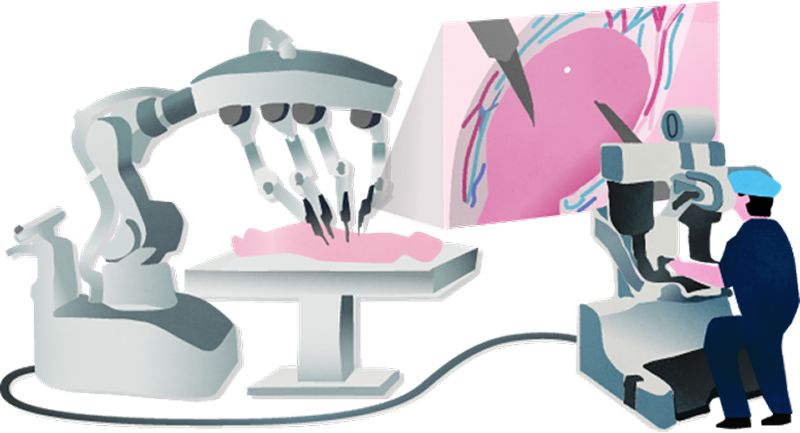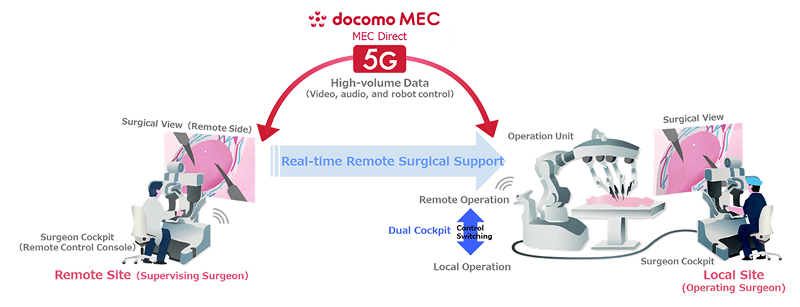Remote Robotic Surgery Powered by 5G Evolution & 6G
Overview
Robot-assisted surgery has been expanding in recent years, and its advanced form of "remote surgery," where doctors perform operations from a distant place using surgical robots, is highly anticipated. NTT DOCOMO is leading the charge in the telecommunications field, collaborating with partners to accelerate the implementation of this innovative medical future.
What is Robot-Assisted Surgery?
Robot-assisted surgery is a procedure performed by a surgeon who controls robotic arms using a dedicated console. The tips of the robotic arms are equipped with long and thin surgical instruments and a camera, enabling more precise and delicate surgery by performing complex movements difficult for human hands and providing magnified 3D views of the surgical site.
Compared to traditional open surgery, robot-assisted surgery requires smaller incisions and, like laparoscopic surgery, is minimally invasive, resulting in faster recovery and less noticeable scarring.
While open surgery and laparoscopic surgery are "Analog Surgeries" where surgeons directly manipulate the affected area with surgical instruments, the introduction of robot-assisted surgery has transformed the process into "Digital Surgery." Surgeons operate a console, their hand movements are converted into digital signals, and the robot manipulates the affected area.

Social Issues in the Medical Industry
Disparities in Medical Care between Urban and Rural Areas:
The depopulation and aging of rural areas have led to a decrease in the number of hospitals and an outflow of doctors to urban areas. As a result, access to advanced medical care, such as robot-assisted surgery, is concentrated in urban areas, widening the gap with rural areas.
Work Style Reform for Doctors:
The concentration of doctors in urban areas leads to patient congestion in large urban hospitals, resulting in increased waiting times for surgery and long working hours for doctors. Work style reforms limiting doctors' working hours could exacerbate the shortage of medical personnel.
Training Opportunities for Young Doctors:
The concentration of doctors performing advanced surgery in urban areas also affects training opportunities for young doctors. Young doctors are required to go to urban hospitals to learn new surgical technologies, leading to a decline in the number of young doctors who wish to train in rural areas. This poses a challenge to maintaining the medical system in rural areas in the future.
Overview of Remote Robotic Surgical Support Solution
Our project is developing a remote robotic surgical support solution by combining the hinotoriTM Surgical Robot System (hereafter referred to as hinotoriTM) *1 with 5G technology.
The entire hinotoriTM system is installed at a local site, while the surgeon cockpit *2 for remote operation is located at a remote site. These two sites are connected via a commercial 5G network and a cloud infrastructure (docomo MEC® *3, MEC Direct® *4). This system allows surgeons in remote locations to operate the cockpit, guiding local surgeries or partially operating the robot remotely, enabling collaborative surgery across distances. Potential use cases include supporting surgeries performed by young doctors in rural areas with experienced doctors in urban centers, as well as applications in surgical education.
This initiative is being conducted with the support of Kobe Vison for the Healthcare of Tomorrow promoted by Kobe City, in collaboration with partners Kobe University and Medicaroid Corporation, through repeated demonstration experiments toward social implementation.

Technical Challenges
By transmitting digitized surgical information over a communication network to a remote location, surgery via remote operation becomes possible. However, this requires overcoming the following technical challenges from a communication perspective.
First, low-latency communication is essential for real-time operation of surgical robots. Latency between sites must be minimized, as any delay can severely impact surgical precision. Second, high-bandwidth communication is required for transmitting high-resolution images, such as endoscopic images. Securing sufficient bandwidth is crucial, as clear images are directly linked to accurate surgical procedures. Finally, high security is imperative. The transmitted information includes sensitive patient medical data, so robust security measures are essential to prevent unauthorized access and data leakage.
Our Technical Features
The following technical assets are utilized:
- 5G Communication: Enables real-time robot operation with high-speed, low-latency communication. Remote robotic surgical support is possible from anywhere with 5G availability.
- docomo MEC: Provides low-latency cloud services through MEC (Multi-access Edge Computing) servers at multiple locations directly connected to the NTT DOCOMO network, enabling real-time robot operation.
- MEC Direct Connection: Achieves secure communication through a closed network connection without going through the internet. Medical information is securely transmitted via a dedicated network.
Summary
Remote robotic surgery has great potential to solve regional medical care disparities and to address the shortage of medical resources. By implementing next-generation networks of 5G Evolution & 6G and achieving lower latency and higher reliability for remote medical care, we will contribute to the further development of the medical industry.
- hinotoriTM Surgical Robot System, manufactured by Medicaroid Corporation, received manufacturing and marketing approval for endoscopic surgical support in the urology field in August 2020. The first surgery was performed in December of the same year. Approval for use in gastroenterological surgery and gynecology was obtained in October 2022, and in respiratory surgery in April 2024, and the number of use cases is currently increasing.
- The surgeon cockpit is a unit of the hinotoriTM Surgical Robot System. The surgeon looks into a 3D viewer and operates the 3D videoscope and instruments attached to the operation unit, where the actual surgery is performed, using hand and foot controls.
- docomo MEC is NTT DOCOMO's cloud service with features such as low latency and high security, which are required for MEC in the 5G era.
- MEC Direct is a service provided by NTT DOCOMO that optimizes communication paths by directly connecting connected devices and the cloud platform, thereby realizing low-latency and high-security communication through 5G.
Past Activities
<Press Releases>
 Japan's First Successful Remote Robotic Surgery Support Demonstration Using "5G Wide" for Stable Communication (June 24, 2024)(PDF format:815KB) (in Japanese only)
Japan's First Successful Remote Robotic Surgery Support Demonstration Using "5G Wide" for Stable Communication (June 24, 2024)(PDF format:815KB) (in Japanese only) Successful Demonstration of Remote Robotic Surgery Support Using Commercial 5G Standalone (SA) Between Tokyo and Kobe (Approx. 500km) (February 1, 2023) (June 24, 2024)(PDF format:634KB) (in Japanese only)
Successful Demonstration of Remote Robotic Surgery Support Using Commercial 5G Standalone (SA) Between Tokyo and Kobe (Approx. 500km) (February 1, 2023) (June 24, 2024)(PDF format:634KB) (in Japanese only) World's First Demonstration of Remote Operation of a Domestically Produced Surgical Support Robot via Commercial 5G (April 16, 2021) (in Japanese only)
World's First Demonstration of Remote Operation of a Domestically Produced Surgical Support Robot via Commercial 5G (April 16, 2021) (in Japanese only)
<Awards>
 SCAT Chairman's Award, 2023 (in Japanese only)
SCAT Chairman's Award, 2023 (in Japanese only) MCPC Award 2021, Mobile Technology Award (in Japanese only)
MCPC Award 2021, Mobile Technology Award (in Japanese only)
<Media Coverage>
 Pioneering the Future of Medical Care with Remote Surgery: Towards the Social Implementation of "Remote Robotic Surgery" Utilizing hinotoriTM and 5G | JOURNAL (Advanced Case Studies and Latest Trends) | OPEN HUB for Smart World, Co-creating the Future (January 24, 2024) (in Japanese only)
Pioneering the Future of Medical Care with Remote Surgery: Towards the Social Implementation of "Remote Robotic Surgery" Utilizing hinotoriTM and 5G | JOURNAL (Advanced Case Studies and Latest Trends) | OPEN HUB for Smart World, Co-creating the Future (January 24, 2024) (in Japanese only) Smart IoT Acceleration Forum IoT Introduction Case Study "Remote Robot Surgery Solution Using 5G - Challenge to Accelerate Innovation through Industry-Academia-Government Collaboration" (March 8, 2022) (in Japanese only)
Smart IoT Acceleration Forum IoT Introduction Case Study "Remote Robot Surgery Solution Using 5G - Challenge to Accelerate Innovation through Industry-Academia-Government Collaboration" (March 8, 2022) (in Japanese only)- NHK BS1 "Our Digital Medical Revolution 2022" (January 2, 2022)
- Denkei Shimbun "Challenges for the New Docomo" (January 1, 2022)
- TV Osaka Medical Special "Connecting Purpose in Life! Robots x Medical Frontline" (December 21, 2021)
- Nippon Television "Shuichi" (December 12, 2021)
Contact
Solution Technology Group
NTT DOCOMO, INC.


